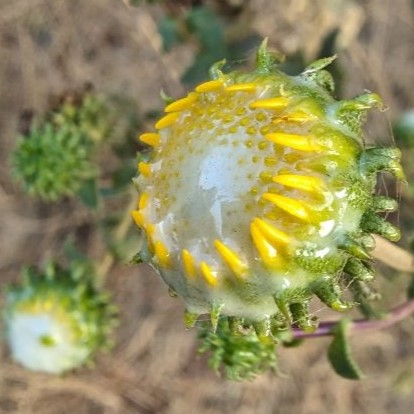
Binomial: Grindelia camporum
Range: Native to California and Baja California, possibly extending into Nevada.
Bloom Period: April to October
The oozing, sticky sheen of great valley gumweed blooms could be seen throughout the trail leading to the Scenic Baldwin Hills Overlook in Los Angeles. An important summer resource for pollinators, this daisy family member has most of the usual characteristics: A row of ray flowers (the “petals”) encircle a small center of yellow disk flowers each of which will develop into a single seed. But it’s the conspicuous gummy white resin produced by the buds and young flowers that make species in this genus unique. The goo is theorized to discourage herbivores and may also provide some UV protection.

Gumplant appears in a wide range of habitats and will readily grow in disturbed areas. It is hardy, needs little water, and is summer semi-deciduous. In the garden setting it can be cut to the ground in late fall or winter and will grow back with winter rain. Somewhat gangly, gumplant can reach heights of 6 feet or more, but within the coastal sage scrub habitat we visited it topped out at 2-3 feet.
We spotted a number of sweat bees and other native species visiting the flowers. We even noticed this fellow – possibly a spotted straw sun moth caterpillar (Heliothis Phloxiphaga), having a chomp. According to calscape.org, it is one of 11 different moth and butterflies thought to be supported by gumweed.

Perhaps one bug’s “glue” is another’s marinara?
